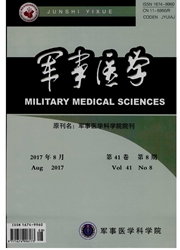

 中文摘要:
中文摘要:
目的:胞红蛋白(CGB)是新近发现的在脊椎动物多种组织中广泛表达的携氧珠蛋白,在肝纤维化过程及缺氧/缺血条件下表达增高,可提高细胞抗氧化损伤能力,但其在细胞保护中的作用机制仍不清楚。由于蛋白质功能的发挥在很大程度上是通过蛋白质-蛋白质相互作用实现的,本研究拟通过研究与功能已知蛋白之间的相互作用,阐明CGB发挥保护作用的分子机制。方法:采用酵母双杂交技术筛选人胎脑cDNA文库,获得与CGB相互作用的阳性克隆并测序、BLAST比对鉴定获得的cDNA序列;随后采用酵母回转实验、免疫荧光共定位及免疫共沉淀实验对蛋白之间的相互作用进行验证。结果:筛选获得的阳性克隆cDNA序列与人金属硫蛋白Ⅱ(MT2)存在100%序列相似性,并且MT2与CGB在酵母和COS7细胞中均存在相互作用。结论:由于MT2为生物体内广泛存在的抗氧化和清除自由基的应激相关蛋白,CGB可能与MT2一起协同调节细胞氧化还原反应能力,进而从抗氧化损伤的角度发挥细胞保护作用。
 英文摘要:
英文摘要:
Objective:To elucidate the molecular mechanism of protective effect of cytoglobin(CGB) against oxidative injury of cells through a study of interactions between CGB and those known. Methods:The yeast two-hybrid system was used to screen the fetal brain cDNA library and to obtain the positive clones interacting with CGB. Then the cDNAs obtained were sequenced and identified by the BLAST program. After that, the protein-protein interaction was further studied by yeast backcross technique and immunofluorescence co-localization and co-immunoprecipitation assay. Results:Metallothionein Ⅱ (MT2) was a candidate protein interacting with CGB. The interaction of CGB with MT2 could be detected both in vitro and in vivo. Conclusion: Since MT2 is expressed in almost each kind of tissues and is considered as a stress-related protein capable of clearing oxidative free radicals and protecting cells against oxidative insult, CGB may combine with MT2 to regulate cellular redox homeostasis and can be used as a means of protecting cells from oxidative injury.
 同期刊论文项目
同期刊论文项目
 同项目期刊论文
同项目期刊论文
 期刊信息
期刊信息
